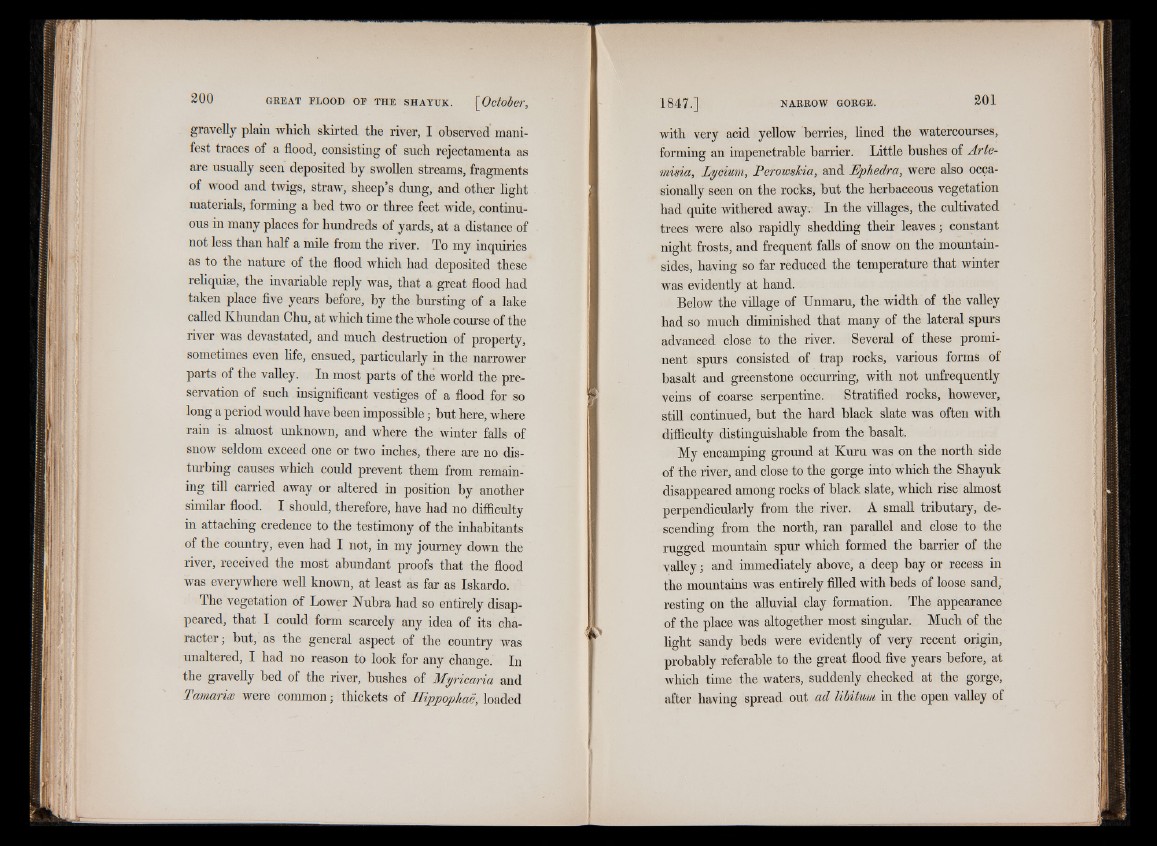
gravelly plain which skirted the river, I observed manifest
traces of a flood, consisting of such rejectamenta as
are usually seen deposited by swollen streams, fragments
of wood and twigs, straw, sheep’s dung, and other light
materials, forming a bed two or three feet wide, continuous
in many places for hundreds of yards, at a distance of
not less than half a mile from the river. To my inquiries
as to the nature of the flood which had deposited these
reliquiae, the invariable reply was, that a great flood had
taken place five years before, by the bursting of a lake
called Khundan Chu, at which time the whole course of the
river was devastated, and much destruction of property,
sometimes even life, ensued, particularly in the narrower
parts of the valley. In most parts of the world the preservation
of such insignificant vestiges of a flood for so
long a period would have been impossible; but here, where
rain is almost unknown, and where the winter falls of
snow seldom exceed one or two inches, there are no disturbing
causes which could prevent them from remaining
till carried away or altered in position by another
similar flood. I should, therefore, have had no difficulty
in attaching credence to the testimony of the inhabitants
of the country, even had I not, in my journey down the
river, received the most abundant proofs that the flood
was everywhere well known, at least as far as Iskardo.
The vegetation of Lower Nubra had so entirely disappeared,
that I could form scarcely any idea of its character
; but, as the general aspect of the country was
unaltered, I had no reason to look for any change. In
the gravelly bed of the river, bushes of Myricaria and
Tamarix were common | thickets of Hippophae, loaded
with very acid yellow berries, lined the watercourses,
forming an impenetrable barrier. Little bushes of Artemisia,
Lycium, PerowsJcia, and Ephedra, were also occasionally
seen on the rocks, but the herbaceous vegetation
had quite withered away. In the villages, the cultivated
trees were also rapidly shedding their leaves; constant
night frosts, and frequent falls of snow on the mountainsides,
having so far reduced the temperature that winter
was evidently at hand.
Below the village of Unmaru, the width of the valley
had so much diminished that many of the lateral spurs
advanced close to the river. Several of these prominent
spurs consisted of trap rocks, various forms of
basalt and greenstone occurring, with not unfrequently
veins of coarse serpentine. Stratified rocks, however,
still continued, but the hard black slate was often with
difficulty distinguishable from the basalt.
My encamping ground at Kuru was on the north side
of the river, and close to the gorge into which the Shayuk
disappeared among rocks of black slate, which rise almost
perpendicularly from the river. A small tributary, descending
from the north, ran parallel and close to the
rugged mountain spur which formed the barrier of the
valley; and immediately above, a deep bay or recess in
the mountains was entirely filled with beds of loose sand,
resting on the alluvial clay formation. The appearance
of the place was altogether most singular. Much of the
light sandy beds were evidently of very recent origin,
probably referable to the great flood five years before, at
which time the waters, suddenly checked at the gorge,
after having spread out ad libitum in the open valley of